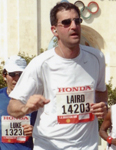
-CIA- World Factbook
-Cool Antarctica
-Discovering Antarctica
-FrankHurley.org

Laird's Bio

Follow Laird at
RunLairdRun.com

Support One of
Laird's Charities
Chapter 11 | Chapter 12 | Chapter 13

Coming to Antarctica to run a marathon may represent some highest level of craziness or adventure. And more than likely both meters read maximum. But the most amazing aspect can truly be summed up in one word: Landing.
The winds noted in the previous chapter finally abated, and we were given the chance to stand on the continent itself. In a small section of Neko Harbor, at 64.5 degrees south by 62.3 degrees west, the amazing crew of the Sea Spirit took us for a Zodiac cruise amongst the icebergs and then landed us on shore. Chelie, the expedition leader shoved blocks of ice out of the way so our boat could make contact with the black sand. She then plopped herself onto the prow and gave us a briefing - where we could walk and when to return. Hands extended to grasp ours as we stepped between the huge ice chunks (never step on one!) and proceeded to higher ground.

Bellinghausen Base (Russia) on King George Island. Site of the Marathon. A Zodiac in the foreground shuttles between the ship and island.
Our boat of 10 people from the "London" group - each of the four groups is named for a major marathon city - included race staff Bill and Jayne and Mike & Vicky plus their kids Sarah and Gavin. Snow pelted us from seemingly all directions; the wind howled and my poor camera dripped water from every corner. Yet, we stood on Antarctica itself. Truly unbelievable. Truly spectacular.
As we walked about 100 feet to the left of the landing, penned in between a huge chunk of melting glacier, water sloughing off in a steady stream, and a rocky and penguin-filled beach, we were happy for our various clothing preparation instructions. At the bottom layer, I sported long underwear. On my torso, that was followed by a Patagonia fleece top and then an IndyCast t-shirt. As an outer layer, I put on a Goretex North Face jacket with fleece liner. A scarf wrapped around my neck for warmth, a comfy goofy-looking ski cap on tap. On the legs above the long underwear were warm sweat pants and then waterproof ski pants above that. The pants were key because they go over our waterproof boots (provided by the ship) that go over my mixed wool & synthetic socks. The boots are tied around the shins and then the pants go over that. So, when we land ashore, we were able to step into the sea water without getting our feet immersed. These are accurately called "wet landings." For safety, the crew requires us to wear life jackets (more of vests really). I carried my camera stuffed inside a waterproof bag which a backpack held inside of it.
Compare that description to the one by in his recent book "Scott of the Antarctic: A Biography."
"A warm thick suit of underclothing formed the innermost layer, followed by a flannel shirt or two, a sweater, pilot-cloth breeches and loosely cut jacket, lots of pockets for knives, matches, goggles and whistles, and an outer suit of thin gaberdine from Messrs. Burberry to keep out the biting wind."
Not all that different actually.
The gear worked great and while I was thoroughly wet from top to bottom on the outside, I stayed dry and cozy on the inside. Well, "cozy" perhaps could be called optimistic in terms of description. Comfortable for sure.
Back to the Top
Chapter 11 | Chapter 12 | Chapter 13


